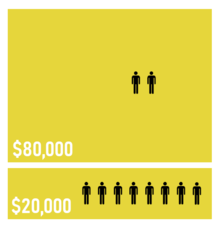This article has multiple issues. Please help improve it or discuss these issues on the talk page. (Learn how and when to remove these messages)
|

The Pareto principle (also known as the 80/20 rule, the law of the vital few and the principle of factor sparsity[1][2]) states that for many outcomes, roughly 80% of consequences come from 20% of causes (the "vital few").[1]
In 1941, management consultant Joseph M. Juran developed the concept in the context of quality control and improvement after reading the works of Italian sociologist and economist Vilfredo Pareto, who wrote in 1906 about the 80/20 connection while teaching at the University of Lausanne.[3] In his first work, Cours d'économie politique, Pareto showed that approximately 80% of the land in the Kingdom of Italy was owned by 20% of the population. The Pareto principle is only tangentially related to the Pareto efficiency.
Mathematically, the 80/20 rule is roughly described by a power law distribution (also known as a Pareto distribution) for a particular set of parameters. Many natural phenomena are distributed according to power law statistics.[4] It is an adage of business management that "80% of sales come from 20% of clients."[5]
- ^ a b Bunkley, Nick (March 3, 2008). "Joseph Juran, 103, Pioneer in Quality Control, Dies". The New York Times. Archived from the original on September 6, 2017. Retrieved 25 January 2018.
- ^ Box, George E.P.; Meyer, R. Daniel (1986). "An Analysis for Unreplicated Fractional Factorials". Technometrics. 28 (1): 11–18. doi:10.1080/00401706.1986.10488093.
- ^ Pareto, Vilfredo (1896–1897). Cours d'Économie Politique (in two volumes). F. Rouge (Lausanne) & F. Pichon (Paris). Volume 1 Volume 2
- ^ Newman, MEJ (2005). "Power laws, Pareto Distributions, and Zipf's law" (PDF). Contemporary Physics. 46 (5): 323–351. arXiv:cond-mat/0412004. Bibcode:2005ConPh..46..323N. doi:10.1080/00107510500052444. S2CID 202719165. Retrieved 10 April 2011.
- ^ Marshall, Perry (2013-10-09). "The 80/20 Rule of Sales: How to Find Your Best Customers". Entrepreneur. Retrieved 2018-01-05.